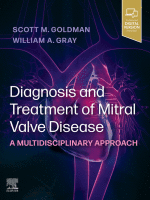Physical Address
304 North Cardinal St.
Dorchester Center, MA 02124

ANSWERS TO THE ASSESSMENT QUESTIONS: Chapter 1: 1) E 2) C 3) A Chapter 2: •Ruptured papillary muscle—Carpentier Type II •Restricted posterior leaflet—Carpentier Type IIIb Chapter 3: 1) E. Class 1 indications (see Fig. 3.1) according to the ACC/AHA guidelines…

LEARNING OBJECTIVES Identify and understand the essential elements of establishing and nurturing a successful mitral valve program. Understand the importance of the skilled mitral surgeon to the success of an effective mitral valve program. Understand and evaluate advanced imaging techniques…

LEARNING OBJECTIVES 1. Establish the key components necessary to market your program as a comprehensive mitral valve program 2. Learn to build a focused outreach plan to optimize internal and external outreach efforts 3. Learn to improve access to care…

LEARNING OBJECTIVES Understand the principles of quality in care delivery and how they relate to mitral valve interventions. Recognize the need for a successful heart team, and each actor’s specific contribution of a growing mitral valve program. Ensure that best…

LEARNING OBJECTIVES After reading this chapter, one should be able to: Identify the multidisciplinary team members. Define the steps for integrating mitral therapy into an established structural heart program. Describe efficient and effective patient care pathways for patients with mitral…

LEARNING OBJECTIVES 1. Review the indications for transcatheter mitral valve therapies according to American Heart Association/American College of Cardiology and European Society of Cardiology guidelines. 2. Review scoring systems for the assessment of favorable anatomy for mitral valve balloon valvuloplasty.…

Learning Objectives While a transcatheter approach has become ubiquitous for aortic valve replacement, transcatheter mitral valve replacement has been slower to gain traction. The more complex anatomy and pathophysiology of mitral valve disease, in comparison to the aortic valve, complicates…

LEARNING OBJECTIVES 1. Patient selection based on anatomical features for percutaneous mitral commissurotomy. 2. Procedural steps of percutaneous mitral commissurotomy. 3. To identify complications of percutaneous mitral commissurotomy and management. 4. Long-term results of percutaneous mitral commissurotomy Kollaborate link: …

LEARNING OBJECTIVES 1. The mitral valve is a complex anatomical structure that can be difficult to treat from a percutaneous standpoint. In-depth anatomic knowledge is essential to procedural success. 2. Currently approved therapies for percutaneous mitral valve repair are based…

Learning Objectives 1. Understand the separate preoperative and intraoperative phases of surgical evaluation of mitral valve (MV) disease. 2. Understand evaluation of MV disease in the preoperative phase of care to include indications for surgery, patient suitability for surgery, and…